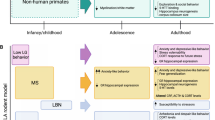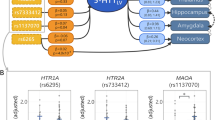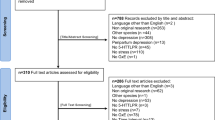Abstract
A functional length variation in the transcriptional control region of the serotonin transporter gene (5-HTTLPR) influences brain function, personality traits, and susceptibility to psychiatric disorders. Here we measured prefrontal brain function by means of event-related potentials during an error processing paradigm. Physiologically, occurrence of an error elicits two specific electrical responses in the prefrontal cortex, the early error related negativity (Ne/ERN) and the later occurring error positivity (Pe), reflecting different components of error processing. Healthy subjects with one or two copies of the low-activity 5-HTTLPR short variant showed significantly higher amplitudes of the Ne/ERN and a trend to higher amplitudes of the Pe as compared to age- and gender-matched individuals homozygous for the long allele. Performance measures and latencies of these ERP-components did not differ between groups. These results indicate that the 5-HTTLPR short variant is associated with enhanced responsiveness of the brain and further supports the notion that prefrontal brain function is influenced by allelic variation in serotonin transporter function.
Similar content being viewed by others

Log in or create a free account to read this content
Gain free access to this article, as well as selected content from this journal and more on nature.com
or
References
Arango V, Underwood MD, Mann JJ (2002). Serotonin brain circuits involved in major depression and suicide. Prog Brain Res 136: 443–453.
Benes FM, Taylor JB, Cunningham MC (2000). Convergence and plasticity of monoaminergic systems in the medial prefrontal cortex during the postnatal period: implications for the development of psychopathology. Cereb Cortex 10: 1014–1027.
Bennett AJ, Lesch KP, Heils A, Long JC, Lorenz JG, Shoaf SE et al (2002). Early experience and serotonin transporter gene variation interact to influence primate CNS function. Mol Psychiatry 7: 118–122.
Caspi A, Sugden K, Moffitt TE, Taylor A, Craig IW, Harrington H et al (2003). Influence of life stress on depression: moderation by a polymorphism in the 5-HTT gene. Science 301: 386–389.
Champoux M, Bennett A, Shannon C, Higley JD, Lesch KP, Suomi SJ (2002). Serotonin transporter gene polymorphism, differential early rearing, and behavior in rhesus monkey neonates. Mol Psychiatry 7: 1058–1063.
Collier DA, Stöber G, Li T, Heils A, Catalano M, Di Bella D et al (1996). A novel functional polymorphism within the promoter of the serotonin transporter gene: possible role in susceptibility to affective disorders. Mol Psychiatry 1: 453–460.
Davidson RJ (2002). Anxiety and affective style: role of prefrontal cortex and amygdala. Biol Psychiatry 51: 68–80.
Falkenstein M, Hohnsbein J, Hoormann J, Blanke L (1991). Effects of crossmodal divided attention on late ERP components. II. Error processing in choice reaction tasks. Electroencephalogr Clin Neurophysiol 78: 447–455.
Fallgatter AJ, Esienack SS, Neuhauser B, Aranda D, Scheuerpflug P, Herrmann MJ (2000). Stability of late event-related potentials: topographical descriptors of motor control compared with the P300 amplitude. Brain Topogr 12: 255–261.
Fallgatter AJ, Jatzke S, Bartsch AJ, Hamelbeck B, Lesch KP (1999). Serotonin transporter promoter polymorphism influences topography of inhibitory motor control. Int J Neuropsychopharmacol 2: 115–120.
Faul F, Erdfelder E (1992). GPOWER: A priori, post-hoc, and compromise power analyses for MS-DOS (computer program). Department of Psychology, Bonn University: Bonn, Germany.
Freedman R, Coon H, Myles-Worsley M, Orr-Urtreger A, Olincy A, Davis A et al (1997). Linkage of a neurophysiological deficit in schizophrenia to a chromosome 15 locus. Proc Natl Acad Sci 94: 587–592.
Gehring WJ, Goss B, Coles MGH, Meyer DE, Donchin E (1993). A neural system for error-detection and compensation. Psychol Sci 4: 385–390.
Gottesman II, Gould TD (2003). The endophenotype concept in psychiatry: etymology and strategic intention. Am J Psychiatry 160: 636–645.
Gratton G, Coles MG, Donchin E (1983). A new method for off-line removal of ocular artifact. Electroencephalogr Clin Neurophysiol 55: 468–484.
Hariri AR, Mattay VS, Tessitore A, Kolachana B, Fera F, Goldman D et al (2002). Serotonin transporter genetic variation and the response of the human amygdala. Science 297: 400–403.
Hariri AR, Weinberger DR (2003). Imaging genomics. Br Med Bull 65: 259–270.
Herrmann MY, Roemmler J, Ehlis AC, Heidrich A, Fallgatter AY (in press). Source localization (LORETA) of the error-related-negativity (ERNINe) and positivity (Pe). Cognit Brain Res.
Holroyd CB, Coles MG (2002). The neural basis of human error processing: reinforcement learning, dopamine, and the error-related negativity. Psychol Rev 109: 679–709.
Jang KL, Hu S, Livesley WJ, Angleitner A, Riemann R, Ando J et al (2001). Covariance structure of neuroticism and agreeableness: a twin and molecular genetic analysis of the role of the serotonin transporter gene. J Pers Soc Psychol 81: 295–304.
Kalayam B, Alexopoulos GS (2003). A preliminary study of left frontal region error negativity and symptom improvement in geriatric depression. Am J Psychiatry 160: 2054–2056.
Lesch KP (2003). Neuroticism and serotonin: a developmental genetic perspective In Plomin R, DeFries J, Craig I, McGuffin P (eds). Behavioral Genetics in the Postgenomic Area. American Psychiatric Press: Washington, DC. pp 389–423.
Lesch KP, Bengel D, Heils A, Sabol SZ, Greenberg BD, Petri S et al (1996). Association of anxiety-related traits with a polymorphism in the serotonin transporter gene regulatory region. Science 274: 1527–1531.
Lesch KP, Mossner R (1998). Genetically driven variation in serotonin uptake: is there a link to affective spectrum, neurodevelopmental, and neurodegenerative disorders? Biol Psychiatry 44: 179–192.
Leuthold H, Sommer W (1999). ERP correlates of error processing in spatial S-R compatibility tasks. Clin Neurophysiol 110: 342–357.
Luu P, Flaisch T, Tucker DM (2000). Medial frontal cortex in action monitoring. J Neurosci 20: 464–469.
Mann JJ, Yung-yu Huang MS, Underwood MD, Kassir SA, Oppenheim S, Kelly TM et al (2000). A serotonin transporter gene promoter polymorphism (5-HTTLPR) and prefrontal cortical binding in major depression and suicide. Arch Gen Psychiatry 57: 729–738.
Nieuwenhuis S, Ridderinkhof KR, Blom J, Band GP, Kok A (2001). Error-related brain potentials are differentially related to awareness of response errors: evidence from an antisaccade task. Psychophysiology 38: 752–760.
Rodriguez-Fornells A, Kurzbuch AR, Münte TF (2002). Time course of error detection and correction in humans: neurophysiological evidence. J Neurosci 22: 9990–9996.
Scheffers MK, Coles MG (2000). Performance monitoring in a confusing world: error related brain activity, judgements of response accuracy, and types of errors. J Exp Psychol Hum Percept Perform 26: 141–151.
Stemmer B, Witzke W, Schönle PW (2001). Losing the error related negativity in the EEG of human subjects: an indicator for willed action. Neurosci Lett 308: 60–62.
Van Veen V, Carter CS (2002). The timing of action-monitoring processes in the anterior cingulate cortex. J Cogn Neurosci 14: 593–602.
Vermetten E, Bremner JD (2002). Circuits and systems in stress. I. Preclinical studies. Depress Anxiety 15: 126–147.
Wu JC, Buchsbaum M, Bunney Jr WE (2001). Clinical implications of sleep deprivation's effect on the anterior cingulate of depressed responders. Neuropsychopharmacology 25: S74–S78.
Acknowledgements
This research was supported in part by a grant from the Deutsche Forschungsgemeinschaft (SFB 581).
Author information
Authors and Affiliations
Corresponding author
Rights and permissions
About this article
Cite this article
Fallgatter, A., Herrmann, M., Roemmler, J. et al. Allelic Variation of Serotonin Transporter Function Modulates the Brain Electrical Response for Error Processing. Neuropsychopharmacol 29, 1506–1511 (2004). https://doi.org/10.1038/sj.npp.1300409
Received:
Revised:
Accepted:
Published:
Issue date:
DOI: https://doi.org/10.1038/sj.npp.1300409
Keywords
This article is cited by
-
The BDNF Val66Met Polymorphism Promotes Changes in the Neuronal Integrity and Alters the Time Perception
Journal of Molecular Neuroscience (2019)
-
Genetic influence alters the brain synchronism in perception and timing
Journal of Biomedical Science (2018)
-
Amino acid challenge and depletion techniques in human functional neuroimaging studies: an overview
Amino Acids (2015)
-
Monoaminergic modulation of behavioural and electrophysiological indices of error processing
Psychopharmacology (2014)
-
The acute effects of MDMA and ethanol administration on electrophysiological correlates of performance monitoring in healthy volunteers
Psychopharmacology (2014)


